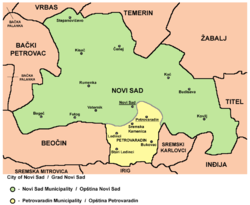Politics of Novi Sad
The edict of empress Maria Theresa of Austria that made Novi Sad a royal free city was proclaimed on February 1, 1748.In various languages it was written as: Neoplantae (Latin), Neusatz (German), Újvidék (Hungarian), and Novi Sad (Serbian).Administrative significance of the city highly increased in 1918, when it became part of the Kingdom of Serbs, Croats and Slovenes.After the war, administrative significance of Novi Sad increased again and it became the capital of the Autonomous Province of Vojvodina within People's Republic of Serbia and new socialist Yugoslavia.From 1980 to 1989, city was divided into seven urban municipalities: Stari Grad, Podunavlje, Liman, Slavija, Petrovaradin, Detelinara and Sremski Karlovci.The executive branch is headed by the Mayor of Novi Sad City, who is elected by direct popular vote.The City's second mayor elected by direct popular vote in September 2004 was Maja Gojković, who is also the only female yet to be the major political figure of Novi Sad.The Assembly monitors performance of city agencies and makes land use decisions as well as legislating on a variety of other issues.[5] Both municipalities, Petrovaradin and Novi Sad, are divided into local communities (Serbian: Mesne zajednice / Месне заједнице).




Novi Sad urban municipality
Petrovaradin urban municipality


Novi SadSerbianVojvodinaHabsburgMilitary Frontierroyal free cityMaria Theresa of AustriaGermanHungarianHungariansVojvodinian SerbsVoivodeship of Serbia and Banat of TemeschwarKingdom of Serbs, Croats and SlovenesBanat, Bačka and BaranjaBačkaDanube BanovinaHorthy'sHungaryPavelić'sIndependent State of CroatiaAutonomous Province of VojvodinaPeople's Republic of Serbiasocialist YugoslaviaStari GradPodunavljeSlavijaPetrovaradinDetelinaraSremski KarlovciMunicipality of Novi Sadlocal communitiesSlovakMayors of Novi SadMaja GojkovićMilan ĐurićSerbian Progressive PartyCity Assembly of Novi SadSNS CoalitionAlliance of Vojvodina HungariansSocialist Party of SerbiaParty of United Pensioners, Farmers, and Proletarians of Serbia – Solidarity and JusticeSerbian Radical PartyMovement of SocialistsSerbian People's PartySerbian Party OathkeepersIndependent Serbian Partypresident of the city assemblySerbian parliamentSerbiaVeternikBegečBudisavaKoviljKisačRumenkaStepanovićevoČenejSremska KamenicaBukovacLedinciStari LedinciSyrmiaConstitution of SerbiaSerbian Renewal MovementList of local communities in Novi SadPetar BojovićBunjevciKingdom of SerbiatwinnedAlexandriaChangchunClevelandDortmundIlioupoliIstočno SarajevoKumanovoModenaNizhny NovgorodNorwichTavernyTimișoaraTolucaBanja LukaEnghien-les-BainsFrunzensky DistrictGothenburgSloveniaKrasnodarOsijekSaint-Leu-la-ForêtShirazSzegedList of honorary citizens of Novi SadWayback MachineHistoryAlmašNeusatz DistrictUnited Serb YouthNovi Sad AssemblyBačka OblastNovi Sad raidNovi Sad AgreementNATO bombingRailway station canopy collapseCity AssemblyPresidentPeopleHonorary citizensStatuteGovernment of VojvodinaAssembly of VojvodinaNeighborhoodsNovi Sad ProperAdamovićevo NaseljeAlmaški KrajAvijatičarsko NaseljeBanatićBistricaBulevarDepresijaGornje LivadeGrbavicaJugovićevoMali BeogradPodbaraRimski Šančevi